Review on Greenhouse Gases Emission in the Association of Southeast Asian Nations (ASEAN) Countries
Abstract
:1. Introduction
2. Methods
- PCFPP,AMS = total installed power generation capacity in AMS.
- PSubC,i = i-th subcritical.
- PSC,i = i-th supercritical.
- PUSC,i = i-th ultra-supercritical.
- PFB,i = i-th fluidized bed.
- t = year of operation.
- EGm,y = the total electricity production by power plant m in year y (MWh).
- EFm,y = CO2 emission factor by power plant m in year y (t-CO2/MWh).
- m = power plant operating in year y.
- y = year of operation.
- EmissionsGHG,fuel = GHG emissions from a particular type of fuel (t-GHGs/year).
- Fuel Consumptionfuel = the amount of fuel used (TJ/year), in this case, the amount of fuel equivalent to the electricity production.
- EFGHG,fuel = default emission factor of a GHG based on a specific fuel type (t-GHGs/TJ).
- EMpy = percentage of energy mix at the end of projection year (%).
- EMby = percentage of energy mix in baseline year (%).
- EGfuel,y = the total electricity production per energy source in year y (GWh).
- EG = the total annual electricity production (GWh).
- EM = percentage of energy mix (%).
- EGcap = electricity production per capita (GWh/capita).
- EGby = the total electricity production in the baseline year (GWh).
- Pby = the population number in the baseline year (capita).
- EG = the total annual electricity production (GWh).
- EGcap = electricity production per capita (GWh/capita).
- P = the population number (capita).
- ER = electrification ratio (%).
3. Results and Discussion
3.1. Baseline Data of Carbon Emissions
3.2. Influencing Factors of Carbon Emissions Level
3.2.1. Population and Economic Growth
3.2.2. Renewable Energy Contribution
3.3. Projection of Carbon Emissions
3.3.1. Emission Intensity Projection
3.3.2. Energy Intensity Projection
3.4. Spatial Distribution Characteristics
3.5. Decarbonization Strategies
4. Conclusions
Author Contributions
Funding
Data Availability Statement
Acknowledgments
Conflicts of Interest
References
- Erdiwansyah; Mahidin; Mamat, R.; Sani, M.S.M.; Khoerunnisa, F.; Kadarohman, A. Target and Demand for Renewable Energy Across 10 ASEAN Countries by 2040. Electr. J. 2019, 32, 106670. [Google Scholar] [CrossRef]
- Ang, B.W.; Su, B. Carbon Emission Intensity in Electricity Production: A Global Analysis. Energy Policy 2016, 94, 56–63. [Google Scholar] [CrossRef]
- Lau, H.C. Decarbonization Roadmaps for ASEAN and Their Implications. Energy Rep. 2022, 8, 6000–6022. [Google Scholar] [CrossRef]
- Shi, X. The Future of ASEAN Energy Mix: A SWOT Analysis. Renew. Sustain. Energy Rev. 2016, 53, 672–680. [Google Scholar] [CrossRef]
- Jiang, H.; Gao, Y.; Xu, P.; Li, J. Study of Future Power Interconnection Scheme in ASEAN. Glob. Energy Interconnect. 2019, 2, 549–559. [Google Scholar] [CrossRef]
- Shi, X. ASEAN Power Grid, Trans-ASEAN Gas Pipeline and ASEAN Economic ASEAN Power Grid, Trans-ASEAN Gas Pipeline and ASEAN Economic Community; ASEAN: Jakarta, Indonesia, 2014; pp. 1–18. [Google Scholar]
- Peng, X.; Tao, X.; Zhang, H.; Chen, J.; Feng, K. CO2 Emissions from the Electricity Sector During China’s Economic Transition: From The Production to the Consumption Perspective. Sustain. Prod. Consum. 2021, 27, 1010–1020. [Google Scholar] [CrossRef]
- Inglesi-Lotz, R.; Dogan, E. The Role of Renewable Versus Non-Renewable Energy to the Level of CO2 Emissions a Panel Analysis of Sub- Saharan Africa’s Βig 10 Electricity Generators. Renew. Energy 2018, 123, 36–43. [Google Scholar] [CrossRef]
- Lau, H.C.; Zhang, K.; Bokka, H.K.; Ramakrishna, S. A Review of the Status of Fossil and Renewable Energies in Southeast Asia and Its Implications on the Decarbonization of ASEAN. Energies 2022, 15, 2152. [Google Scholar] [CrossRef]
- Ahmed, T.; Mekhilef, S.; Shah, R.; Mithulananthan, N.; Seyedmahmoudian, M.; Horan, B. ASEAN Power Grid: A Secure Transmission Infrastructure for Clean and Sustainable Energy for South-East Asia. Renew. Sustain. Energy Rev. 2017, 67, 1420–1435. [Google Scholar] [CrossRef]
- ASEAN Plan of Action for Energy Cooperation (APAEC) 2016–2025; The ASEAN Centre for Energy: Jakarta, Indonesia, 2015.
- Namahoro, J.P.; Wu, Q.; Xiao, H.; Zhou, N. The Impact of Renewable Energy, Economy and Population Growth on CO2 Emissions in the East African Region: Evidence from Common Correlated Effect Means Group and Asymmetric Analysis. Energies 2021, 14, 312. [Google Scholar] [CrossRef]
- Zaekhan, Z.; Nachrowi, N.D. The Lmpact of Renewable Energy and GDP per Capita on Carbon Dioxide Emission in the G-20 Countries. Econ. Financ. Indones. 2015, 60, 145–174. [Google Scholar] [CrossRef]
- Akpan, G.E.; Akpan, U.F. Electricity Consumption, Carbon Emissions and Economic Growth in Nigeria. Int. J. Energy Econ. Policy 2012, 2, 292–306. [Google Scholar]
- Ahmad, N.; Du, L. Effects of Energy Production and CO2 Emissions on Economic Growth in Iran: ARDL Approach. Energy 2017, 123, 521–537. [Google Scholar] [CrossRef]
- Malla, S. CO2 Emissions from Electricity Generation in Seven Asia-Pacific and North American Countries: A Decomposition Analysis. Energy Policy 2009, 37, 1–9. [Google Scholar] [CrossRef]
- Saidi, K.; Hammami, S. The Impact of CO2 Emissions and Economic Growth on Energy Consumption in 58 Countries. Energy Rep. 2015, 1, 62–70. [Google Scholar] [CrossRef]
- Sahin, H.; Esen, H. The Usage of Renewable Energy Sources and Its Effects on GHG Emission Intensity of Electricity Generation in Turkey. Renew. Energy 2022, 192, 859–869. [Google Scholar] [CrossRef]
- Orfanos, N.; Mitzelos, D.; Sagani, A.; Dedoussis, V. Life-Cycle Environmental Performance Assessment of Electricity Generation and Transmission Systems in Greece. Renew. Energy 2019, 139, 1447–1462. [Google Scholar] [CrossRef]
- Li, X.; Chalvatzis, K.J.; Pappas, D. China’s Electricity Emission Intensity in 2020—An Analysis at Provincial Level. Energy Procedia 2017, 142, 2779–2785. [Google Scholar] [CrossRef]
- Jafari, Y.; Othman, J.; Nor, A.H.S.M. Energy Consumption, Economic Growth and Environmental Pollutants in Indonesia. J. Policy Model. 2012, 34, 879–889. [Google Scholar] [CrossRef]
- ASEAN CO2 Emissions from Coal-Fired Power Plants: A Baseline Study; The ASEAN Centre for Energy: Jakarta, Indonesia, 2021.
- IEA. Technology Roadmap High-Efficiency, Low-Emissions Coal-Fired Power Generation; IEA: Paris, France, 2012. [Google Scholar]
- Brunei Darussalam National Determined Contribution (NDC) 2020; Ministry of Development Brunei Darussalam: Bandar Seri Begawan, Brunei, 2020.
- Philippine Energy Plan (PEP) 2018–2040; Department of Energy Republic of the Philippines: Taguig City, Philippines, 2018.
- Rencana Usaha Penyediaan Tenaga Listrik (RUPTL) PT PLN (Persero) 2021–2030; PLN: Jakarta, Indonesia, 2021.
- The General Department of Energy With Input From the General Department of Petroleum, M. of Mi. and E. of C. In Cambodia Basic Energy Plan; Economic Research Institute for ASEAN and East Asia (ERIA): Jakarta, Indonesia, 2019.
- Power Development Plan 2020–2030 of Lao PDR; Ministry of Energy and Mines Lao PDR: Vientiane, Laos, 2020.
- Malaysian Investment Development Authority. Available online: https://www.mida.gov.my/ (accessed on 22 December 2021).
- The Government of the Republic of the Union of Myanmar National Energy Management Committee. Myanmar Energy Master Plan. 2015. Available online: https://policy.asiapacificenergy.org/node/2923 (accessed on 1 December 2021).
- Singapore’s Update of Its First Nationally Determined Contribution (NDC) and Accompanying Information. Singapore, 2020.
- Thailand Power Development Plan 2018–2037 (PDP 2018); Ministry of Energy: Bangkok, Thailand, 2018.
- Farley, W. Williams Vietnam’s Draft Master Plan VIII-What It Means For Renewable Energy. Available online: https://www.wfw.com/articles/vietnams-draft-master-plan-viii-what-it-means-for-renewable-energy/ (accessed on 1 December 2021).
- UNFCCC Tools to Calculate the Emission Factor for an Electricity System. Available online: https://cdm.unfccc.int/methodologies/PAmethodologies/tools/am-tool-07-v1.1.pdf/history_view (accessed on 15 November 2021).
- Gomez, D.R.; Watterson, J.D.; Americano, B.B.; Ha, C.; Marland, G.; Matsika, E.; Namayanga, L.N.; Osman-Elasha, B.; Saka, J.D.K.; Treanton, K. Chapter 2: Stationary Combustion. In IPCC Guidelines for National Greenhouse Gas Inventories; Institute for Global Environmental Strategies: Kanagawa, Japan, 2006; pp. 1–48. [Google Scholar]
- IEA Data and Statistics. Available online: https://www.iea.org/data-and-statistics. (accessed on 15 November 2021).
- Data Commons Timeline. Available online: https://datacommons.org/tools/timeline#&place=Earth&statsVar=Count_Person. (accessed on 20 November 2021).
- Vivid Amalia Khusna; Deni Kusumawardani Decomposition of Carbon Dioxide (CO2) Emissions in ASEAN Based on Kaya Identity. Indones. J. Energy 2021, 4, 101–114. [CrossRef]
- IEA Fuels and Technologies. Available online: https://www.iea.org/fuels-and-technologies (accessed on 15 November 2021).
- Statista. Available online: https://www.statista.com/statistics/796245/gdp-of-the-asean-countries/ (accessed on 15 November 2021).
- Phoumin, H.; Herberg, M.E.; Tsafos, N.; Weatherby, C. Powering Southeast Asia Meeting The Region’s Electricity Needs; The National Bureau of Asian Research: Seattle, DC, USA; Washington, DC, USA, 2020. [Google Scholar]
- Overland, I.; Sagbakken, H.F.; Chan, H.-Y.; Merdekawati, M.; Suryadi, B.; Utama, N.A.; Vakulchuk, R. The ASEAN Climate and Energy Paradox. Energy Clim. Chang. 2021, 2, 100019. [Google Scholar] [CrossRef]
- Kyophilavong, P.; Souphonphacdy, D.; Komany, S.; Tounalom, K. Decarbonization in Lao PDR: The Options and Challenges. 2021. Available online: https://www.climateworkscentre.org/wp-content/uploads/2022/02/Lao-PDR-Report-Phase-1_Sept-21.pdf (accessed on 13 February 2023).
- Asian Development Bank. Lao People’s Democratic Republic Energy Sector Assessment, Strategy, and Road Map; Asian Development Bank: Mandaluyong, Philippines, 2019. [Google Scholar]
- Lau, H.C. Decarbonization of ASEAN’s Power Sector: A Holistic Approach. Energy Rep. 2023, 9, 676–702. [Google Scholar] [CrossRef]
- Tongsopit, S.; Kittner, N.; Chang, Y.; Aksornkij, A.; Wangjiraniran, W. Energy Security in ASEAN: A Quantitative Approach for Sustainable Energy Policy. Energy Policy 2016, 90, 60–72. [Google Scholar] [CrossRef]
- Anbumozhi, V.; Arriola, F.; Burell, A.; Connet, D.; Dhakal, S.; Duan, X.; Huang, Z.; Jett, A.; Lu, X.; Malang, L.; et al. Financing Clean Energy in Developing Asia; Susantono, B., Zhai, Y., Shrestha, R.M., Mo, L., Eds.; Asia Development Bank: Mandaluyong, Philippines, 2021; Volume 1, ISBN 9789292629861. [Google Scholar]
- Arinaldo, D.; Prasojo, H.; Tampubolon, A.P.; Simamora, P.; Kurniawan, D.; Marciano, I.; Adiatma, J.C. Indonesia Energy Transition Outlook 2021: Tracking Progress of Energy Transition in Indonesia; Institute for Essential Services Reform (IESR): Jakarta, Indonesia, 2021; pp. 1–93. [Google Scholar]
- Pan, B.; Adebayo, T.S.; Ibrahim, R.L.; Al-Faryan, M.A.S. Does Nuclear Energy Consumption Mitigate Carbon Emissions in Leading Countries by Nuclear Power Consumption? Evidence from Quantile Causality Approach. Front. Environ. Sci. 2022, 1–23. [Google Scholar] [CrossRef]
- Sasmoko; Imran, M.; Khan, S.; Khan, H.U.R.; Jambari, H.; Musah, M.B.; Zaman, K. War Psychology: The Global Carbon Emissions Impact of the Ukraine-Russia Conflict. Front. Environ. Sci. 2023, 11, 228. [Google Scholar] [CrossRef]

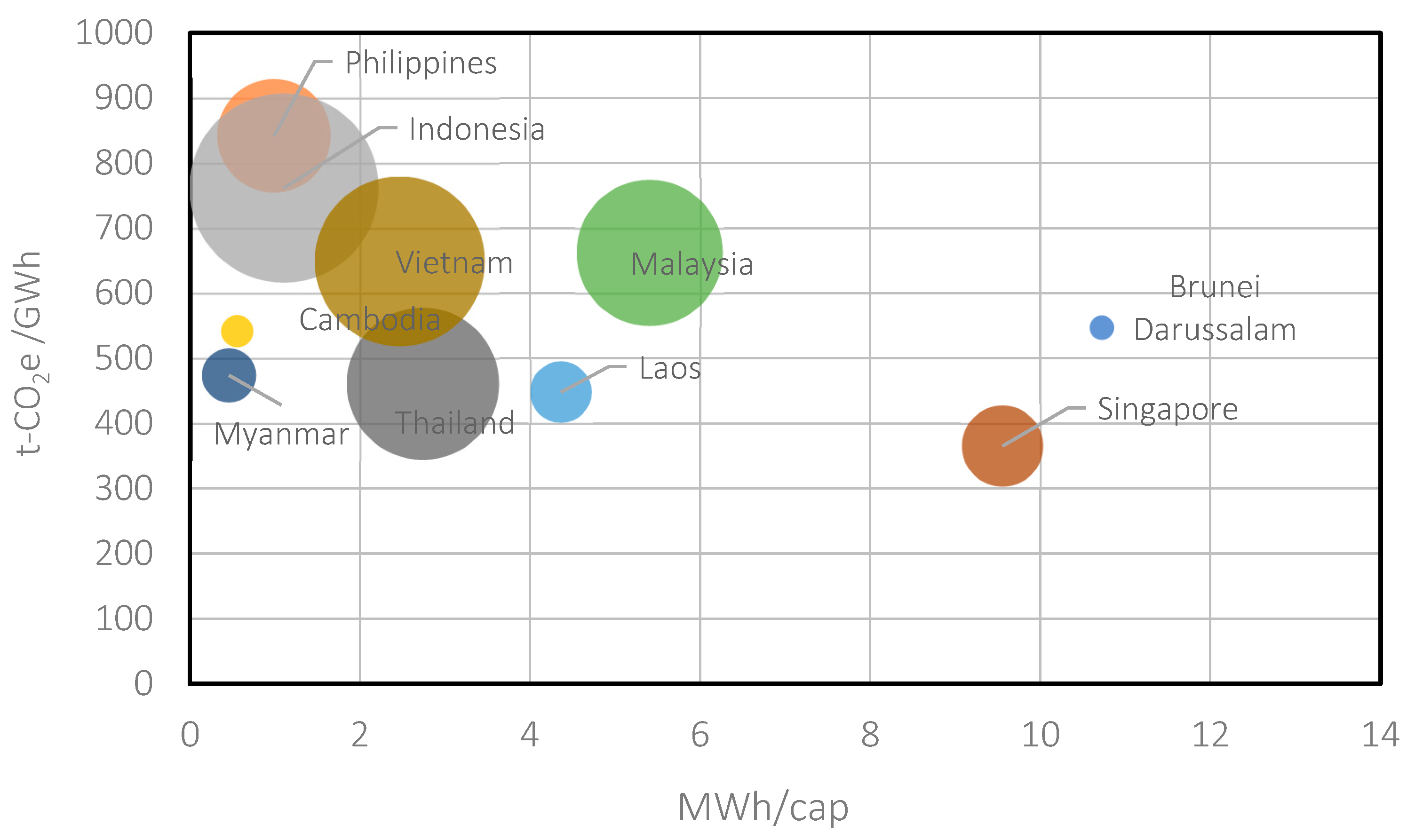
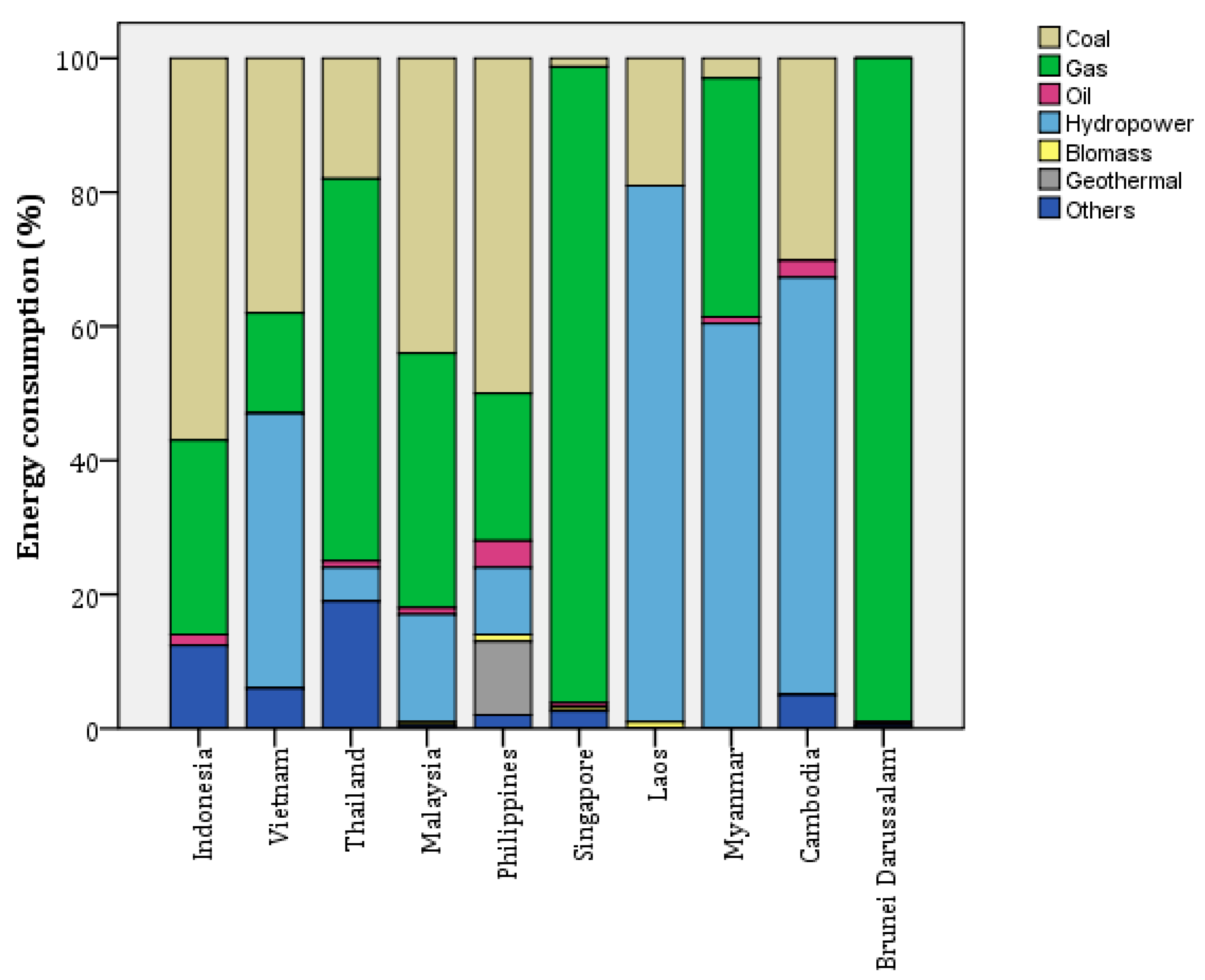
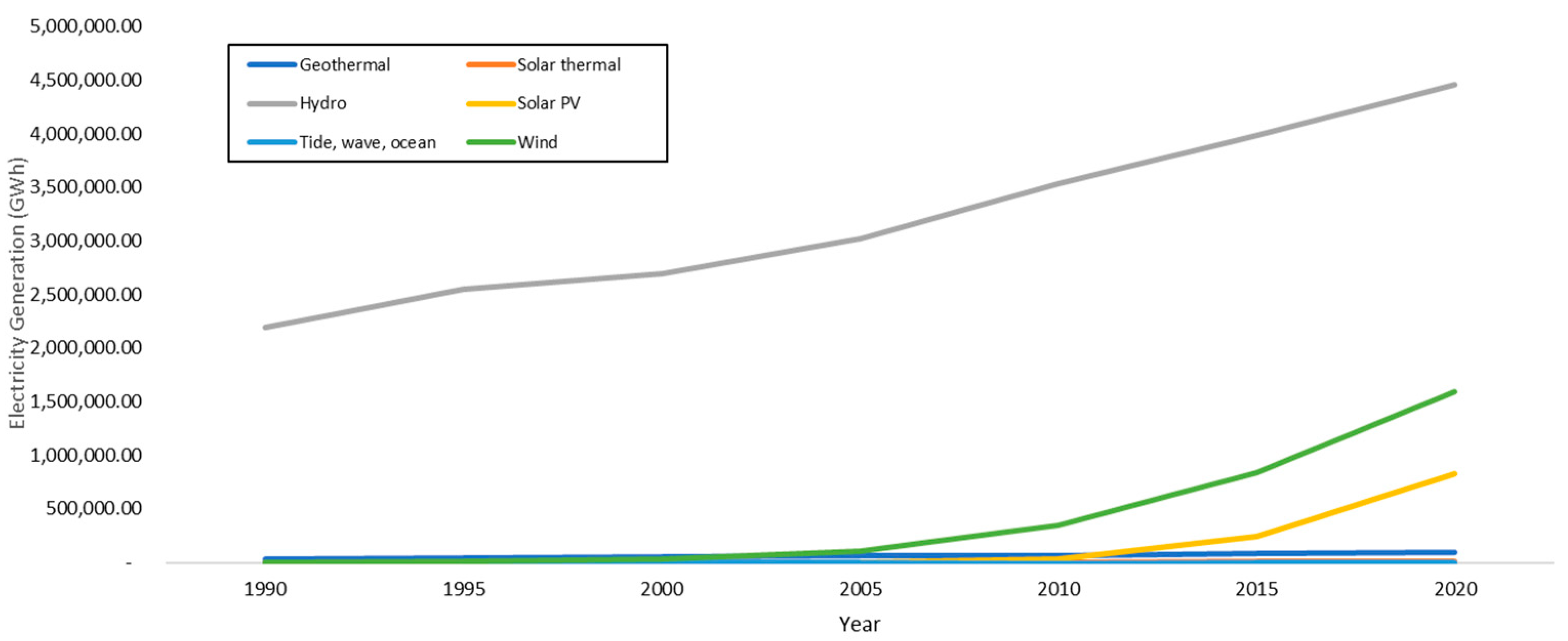
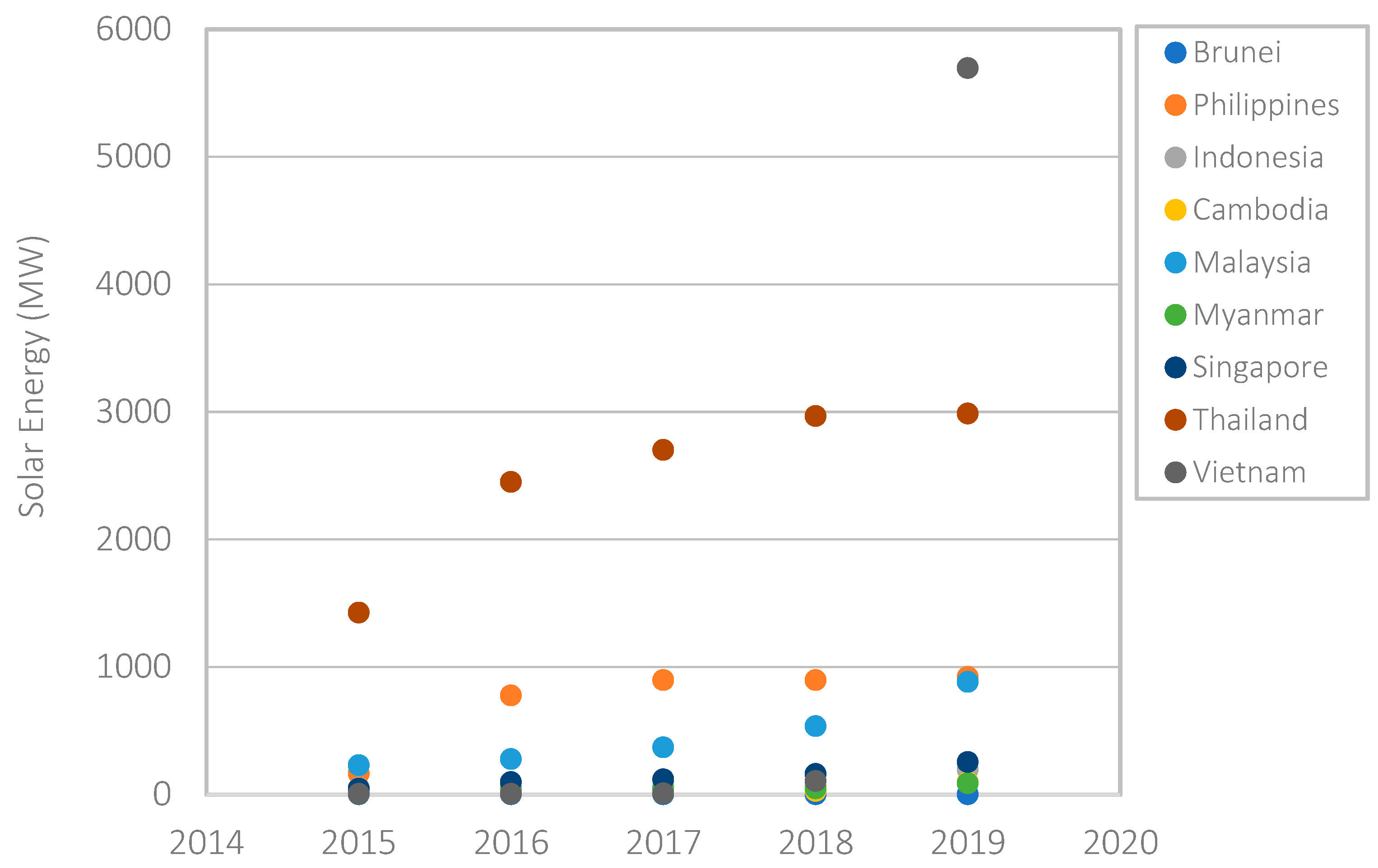

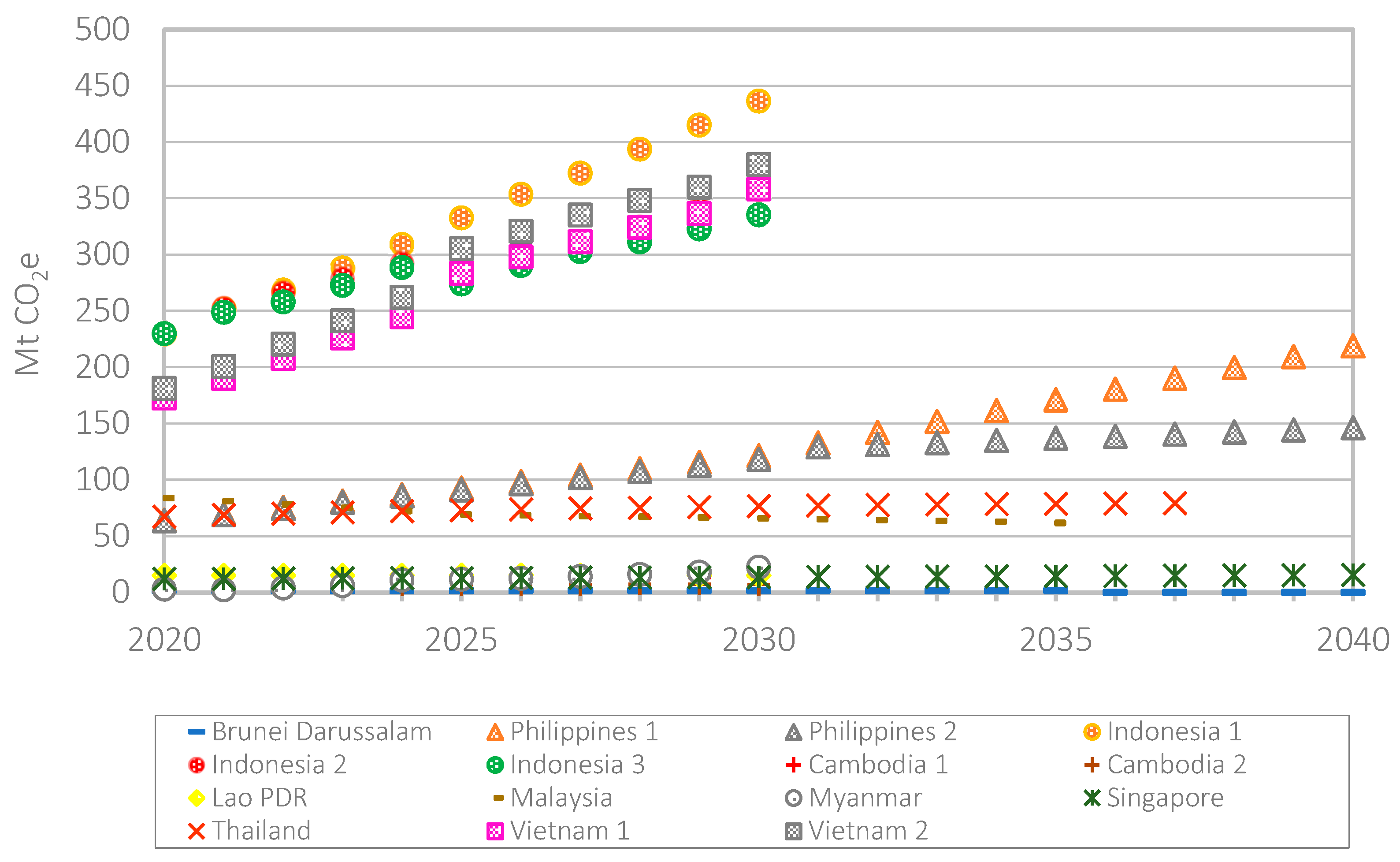
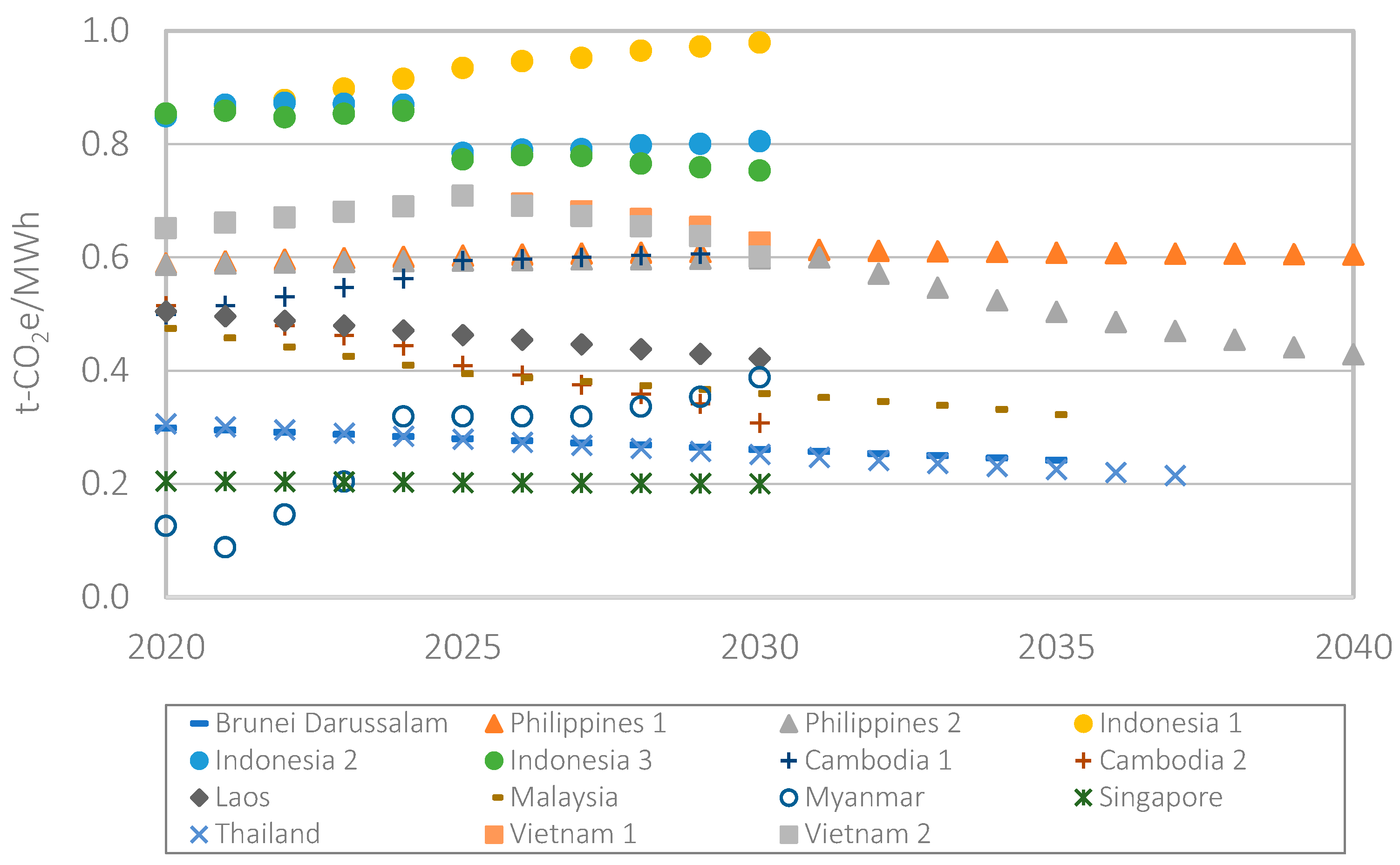
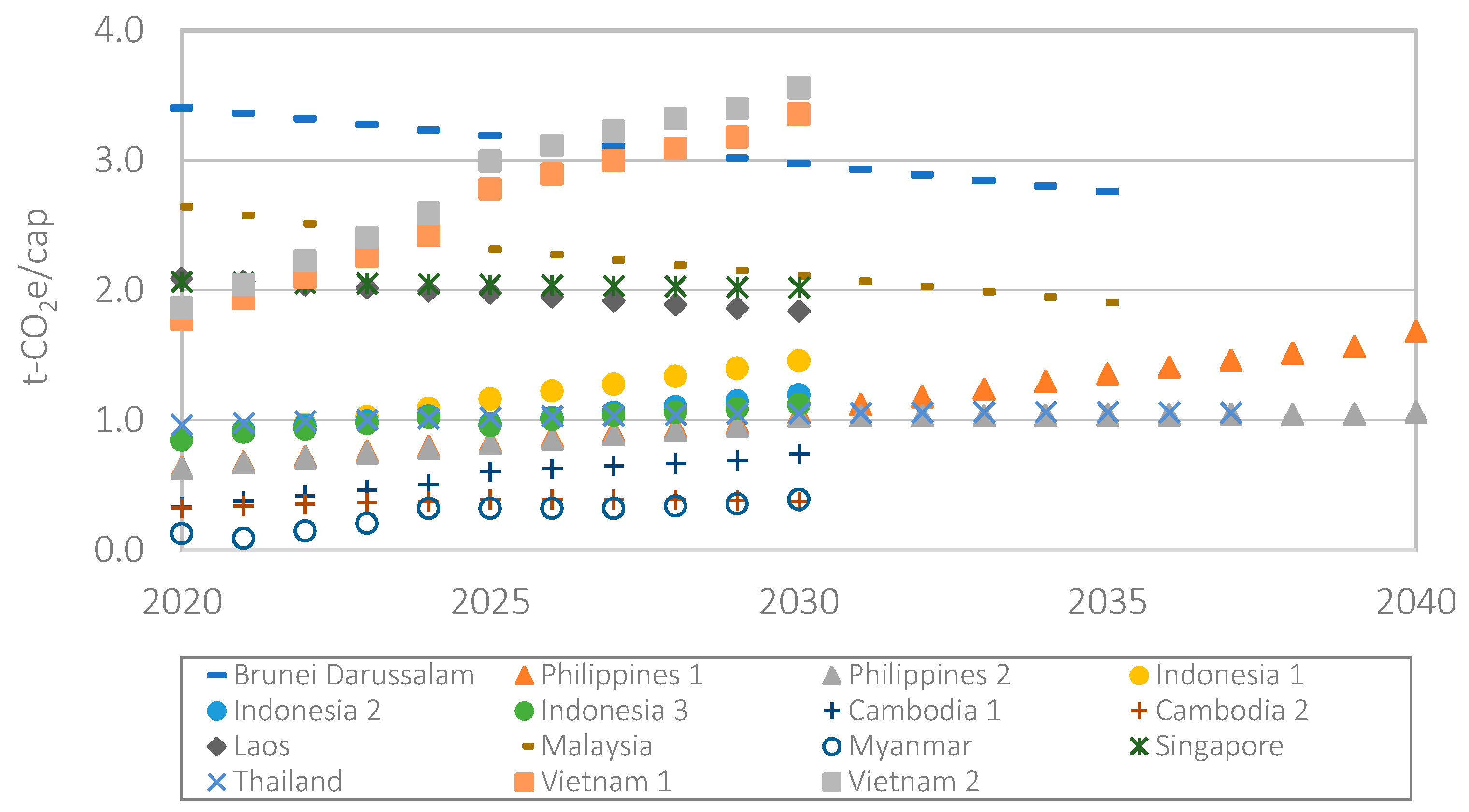
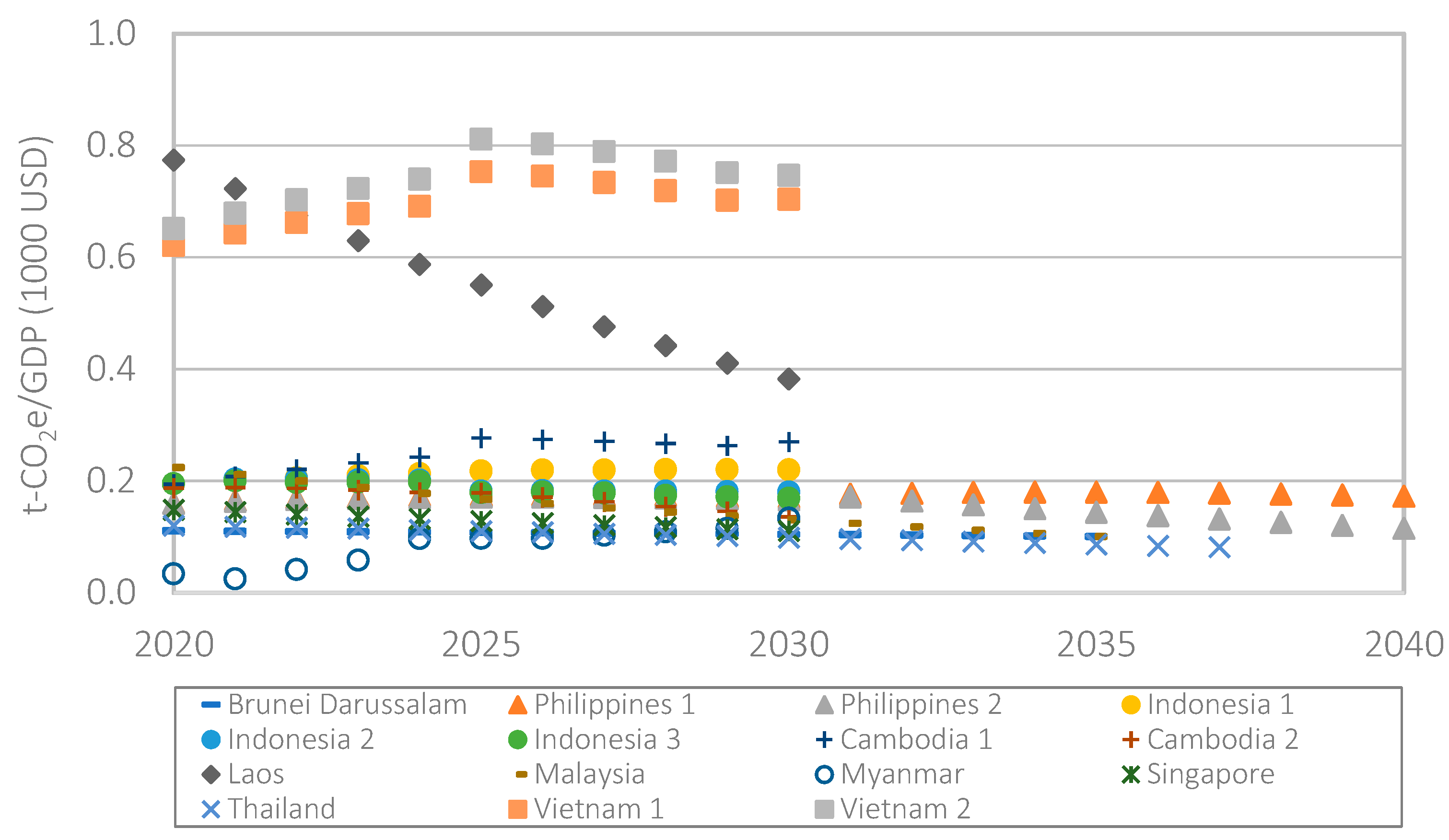


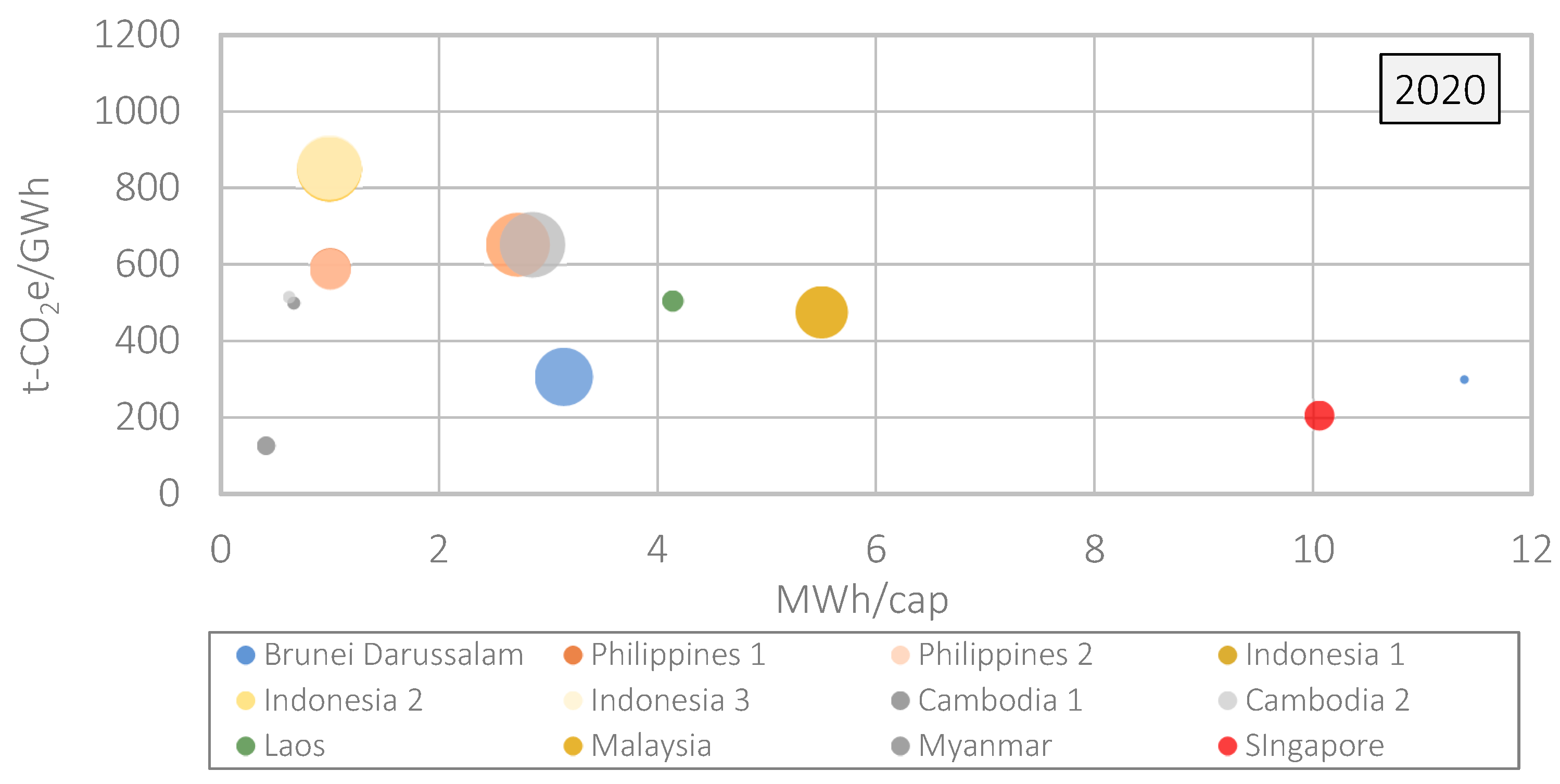

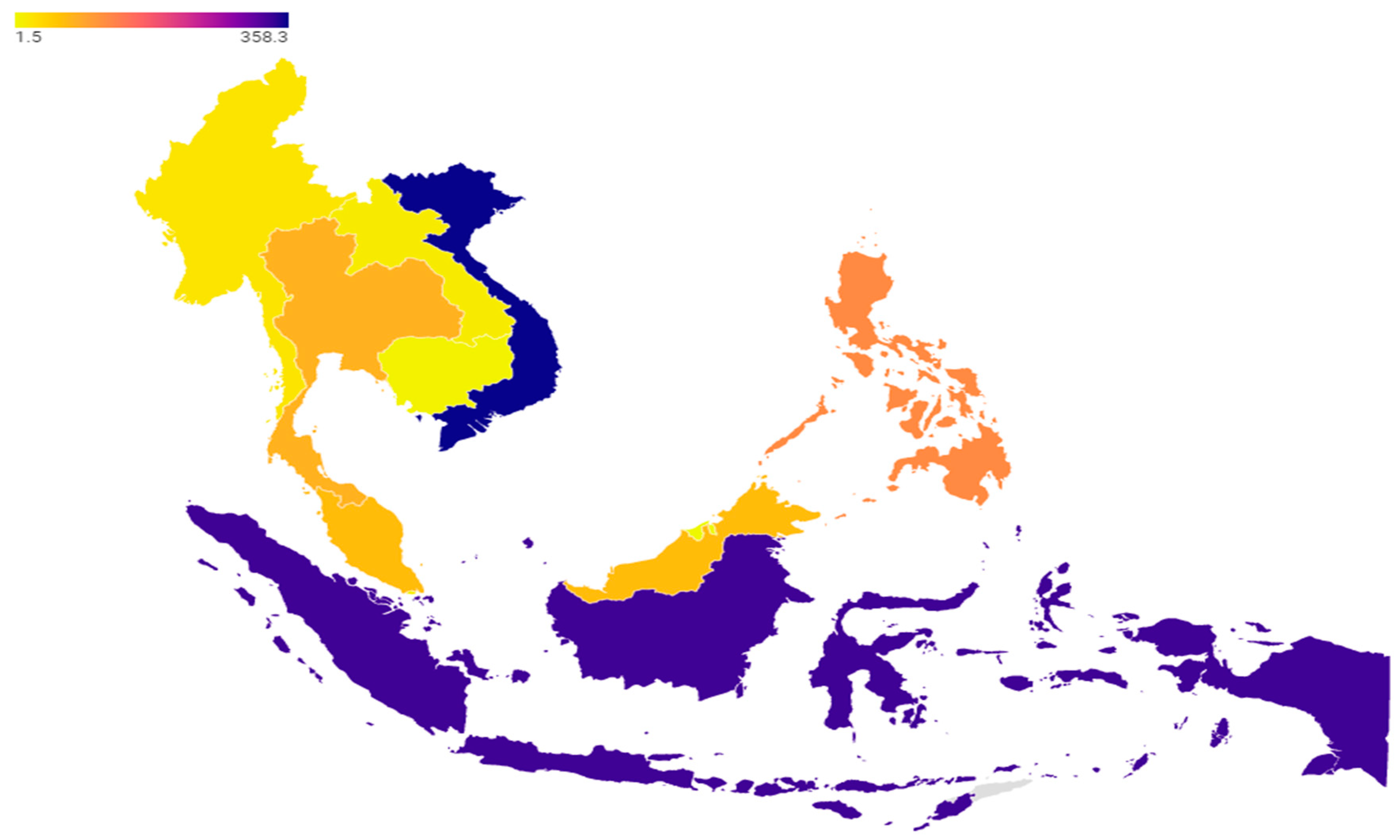
| Country | Target | Reference |
|---|---|---|
| Brunei Darussalam | RE 30% by 2035 | [24] |
| Philippines 1 (Reference Scenario) | RE 34.13%, coal 58.36%, oil 0.62%, gas 6.89% by 2030 RE 26.31%, coal 55.34%, oil 0.31%, gas 18.03% by 2040 | [25] |
| Philippines 2 (Clean Energy Scenario) | RE 31.9%, coal 56.16%, oil 0.63%, gas 11.31% by 2030 RE 38.15%, coal 34.22%, oil 0.33%, gas 27.29% by 2040 | [25] |
| Indonesia 1 (Business as Usual) | RE 8.21%, coal 78.71%, oil 0.41%, gas 12.67% by 2030 | [26] |
| Indonesia 2 (Optimal Scenario) | RE 22.83%, coal 64.09%, oil 0.41%, gas 12.67% by 2030 | [26] |
| Indonesia 3 (Low Carbon Scenario) | RE 24.78%, coal 59.37%, oil 0.4%, gas 15.44% by 2030 | [26] |
| Cambodia 1 (Existing Scenario) | RE 32.8%, coal 52.2%, oil 15% by 2020 RE 26%, coal 64.8%, oil 9.2% by 2025 RE 25.4%, coal 67.5%, oil 7.2% by 2030 | [27] |
| Cambodia 2 (Aggressive Scenario) | RE 35.8%, coal 56%, oil 8.1% by 2020 RE 53.3%, coal 46.4% by 2025 RE 65%, coal 35% by 2030 | [27] |
| Laos | RE 70%, coal 30% by 2030 | [28] |
| Malaysia | RE 31%, coal 31.38%, oil 0.55%, gas 37.07% by 2025 RE 40%, coal 22.38%, oil 0.55%, gas 37.07% by 2035 | [29] |
| Myanmar | RE 74.1%, coal 3.4%, gas 22.4% by 2021 RE 64%, coal 23.3%, gas 12.7% by 2024 RE 67.7%, coal 24%, gas 8.3% by 2027 RE 62.3%, coal 29.5%, gas 8.2% by 2030 | [30] |
| Singapore | RE 3% (2 GWp by solar) by 2030 | [31] |
| Thailand | RE 36%, coal 11%, gas 53% by 2037 | [32] |
| Vietnam 1 (Base Load Scenario) | RE 34.3%, coal 58.73%, gas 6.97% by 2025 RE 28.79%, coal 49.2%, gas 22.01% by 2030 | [33] |
| Vietnam 2 (High Load Scenario) | RE 34.3%, coal 58.73%, gas 6.97% by 2025 RE 28.79%, coal 49.2%, gas 22.01% by 2030 | [33] |
| Country | Electricity Used (TWh) | RE Share on Energy Mix (%) | Population (Thousand) | GDP (Billions USD) | Total Area (Sq. Km) |
|---|---|---|---|---|---|
| Brunei Darussalam | 5.3 | 0.5 | 433.3 | 13.5 | 5765.0 |
| Philippines | 92 | 1.0 | 108,116.6 | 376.8 | 300,000.0 |
| Indonesia | 268.1 | 12.4 | 270,625.6 | 1120.0 | 1,913,578.7 |
| Cambodia | 11.5 | 3.5 | 16,486.5 | 26,7 | 181,035.0 |
| Laos | 7.7 | 71.6 | 7169.5 | 18.8 | 236,800.0 |
| Malaysia | 168.3 | 0.5 | 31,949.8 | 364.7 | 331,388.0 |
| Myanmar | 15.1 | 0.1 | 54,703.6 | 68.8 | 676,576.0 |
| Singapore | 52.9 | 0.3 | 5703.6 | 374.4 | 728.0 |
| Thailand | 193.4 | 19 | 69,625.6 | 544.1 | 513,139.0 |
| Vietnam | 226 | 6 | 96,462.1 | 329.5 | 331,317.0 |
| Country | Δ (2030–2020) | ||
|---|---|---|---|
| GWh | t-CO2e/GWh | MWh/cap | |
| Brunei Darussalam | 572 | −37.9 | - |
| Philippines 1 | 98,721 | 20.4 | 0.65 |
| Philippines 2 | 98,086 | 10.7 | 0.65 |
| Indonesia 1 | 174,852 | 130.1 | 0.49 |
| Indonesia 2 | 174,852 | −44.0 | 0.49 |
| Indonesia 3 | 175,852 | −100.6 | 0.49 |
| Cambodia 1 | 12,424 | 113.1 | 0.54 |
| Cambodia 2 | 13,111 | −206.9 | 0.58 |
| Laos | 6005 | −83.3 | 0.22 |
| Malaysia | 27,635 | −148.9 | - |
| Myanmar | 43,244 | 275.8 | 0.70 |
| Singapore | 9305 | −4.3 | - |
| Thailand | 83,192 | −53.6 | 1.02 |
| Vietnam 1 | 307,000 | −25.4 | 2.63 |
| Vietnam 2 | 354,000 | −50.4 | 3.06 |
Disclaimer/Publisher’s Note: The statements, opinions and data contained in all publications are solely those of the individual author(s) and contributor(s) and not of MDPI and/or the editor(s). MDPI and/or the editor(s) disclaim responsibility for any injury to people or property resulting from any ideas, methods, instructions or products referred to in the content. |
© 2023 by the authors. Licensee MDPI, Basel, Switzerland. This article is an open access article distributed under the terms and conditions of the Creative Commons Attribution (CC BY) license (https://creativecommons.org/licenses/by/4.0/).
Share and Cite
Triani, M.; Tambunan, H.B.; Dewi, K.; Ediansjah, A.S. Review on Greenhouse Gases Emission in the Association of Southeast Asian Nations (ASEAN) Countries. Energies 2023, 16, 3920. https://doi.org/10.3390/en16093920
Triani M, Tambunan HB, Dewi K, Ediansjah AS. Review on Greenhouse Gases Emission in the Association of Southeast Asian Nations (ASEAN) Countries. Energies. 2023; 16(9):3920. https://doi.org/10.3390/en16093920
Chicago/Turabian StyleTriani, Meiri, Handrea Bernando Tambunan, Kania Dewi, and Addina Shafiyya Ediansjah. 2023. "Review on Greenhouse Gases Emission in the Association of Southeast Asian Nations (ASEAN) Countries" Energies 16, no. 9: 3920. https://doi.org/10.3390/en16093920







